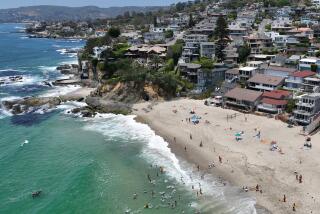Fence Blocking Off Famed Beach Becomes a Line Drawn in the Sand
- Share via
For more than 50 years, volleyball players have shared the sands of Sorrento Beach in Santa Monica with the rich and famous who reside in the ivy-covered mansions between the ocean and Pacific Coast Highway. Relations have been mostly amicable. Until now.
On Sept. 4, volleyball players on their way to the beach were shocked to find that a 50-foot-long chain link fence had been constructed by residents at the 25-unit Sorrento condominium complex, blocking their way to the playing area.
The ensuing uproar over the fence has reignited a debate over just who owns the beach.
Condominium owners say their property deed shows that the beach they have fenced off is theirs. Steve Agnew, president of the Sorrento homeowners group, said the fence was erected for security reasons. “I don’t like to say this, but volleyball players do a lot of drugs,” Agnew said. He said players also “use the corner of our building for a bathroom.”
The volleyball players say the homeowners blame them for wrongs committed by homeless people who sleep on the dunes at night. They maintain that the beach is public property.
They apparently feel so strongly about the issue that someone used wire-cutters to open the fence last Sunday.
Agnew rushed outside to try to stop the man. “To hell with you,” the man said to Agnew, and finished the job. Agnew called the police, but by the time they arrived, the fence-cutter had vanished into a supportive crowd of slim, tan volleyball players.
“Someone used self-help to liberate the pathway in the old tradition of the Tea Party,” said Bradley Brunon, a lawyer and player who was at the scene. The fence remains slashed open. “I just walk through the same as I have been for 40 years,” said Jack Kerns, an old-timer known as “Pop” who said he almost took wire cutters to the fence himself.
Sorrento Beach, owned by the state and operated by the city of Santa Monica, is regarded as one of the birthplaces of beach volleyball. Back in the ‘50s and ‘60s, studs and stars such as the legendary Ron Von Hagen played from dawn to dusk at the site north of the Jonathan Club. On the sidelines, girls in bobs and bathing suits swooned. Nights were party time at the Sorrento Grille, where a huge mug of beer cost only 50 cents and the jukebox was always playing. Out in the parking lot, young kids sat in their hot rods and jalopies, listening to the sea and making out.
But after the Sorrento Grille was razed to make way for the condominiums, there was no place to get a hamburger, and parking cost big bucks, so many of the best players went to other beaches. Many of the regulars now are old-timers with nostalgic memories.
Dave Heiser, a player who has used the beach since 1939, recalls the days when Marilyn Monroe hung out there. Actor Peter Lawford and Pat Kennedy owned a mansion there, and Lawford, zinc oxide on his handsome nose, often played ball. Youngsters from the mansions joined in the games.
Things are different now, Heiser said. “These days people live in the houses for prestige. They use the beach only to walk their dogs,” he said. “But people who used to live in the houses accepted the beach people in front of them. They were beach users, too. Life was so beautiful then.”
Maybe so, but even then there were property disputes between the homeowners and the city. By law, all land seaward of the mean high tide line, or high-water mark, is public property. In the late ‘40s, when the Pacific Coast Highway was nothing but a dirt road, the ocean lapped right up to the walls around the mansions. But when the breakwater was built, it expanded the sandy beach nearly fourfold and made the location of the high-water mark subject to debate.
In the early ‘60s, some private homeowners quietly began to expand their plots, moving their fences out onto what had been volleyball territory. The city initially fought the moves, Heiser and Kerns recalled, but suddenly let the matter drop. Many old-timers say the Kennedy name may have been the cause. “We figured--and Peter told me when he was alive--that they had a lot of juice,” Heiser said.
The controversy flared again in the ‘70s, when several of the mansions again attempted to build their fences farther out onto the beach. The city settled that matter by allowing certain homeowners--and the Jonathan Club--to lease land from the public in return for agreeing that private property ends where the mean high-tide line was established in 1921, before the breakwater expanded the beach.
On the most recent dispute, Mary Strobel, deputy city attorney, said that unless the Sorrento condominiums were among the parcels included in that settlement, its fence is probably on public property and must be taken down. She is investigating the matter.
Sorrento homeowners, somewhat stunned by the outrage their fence provoked, held a meeting Tuesday night and decided not to contest the city’s final decision. “We’re not land barons. When push comes to shove, we’re not interested in a long court battle,” Agnew said. “We’ve done without a fence for 14 years, and if we have to we can continue to live without it.”
More to Read
Go beyond the scoreboard
Get the latest on L.A.'s teams in the daily Sports Report newsletter.
You may occasionally receive promotional content from the Los Angeles Times.










